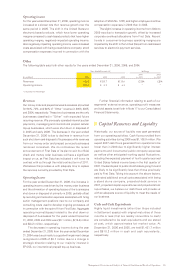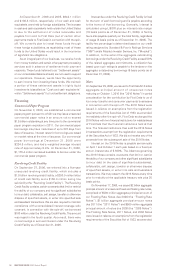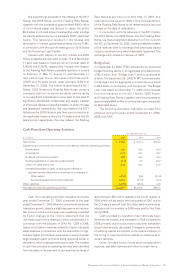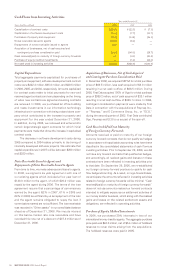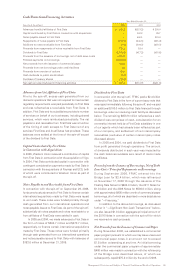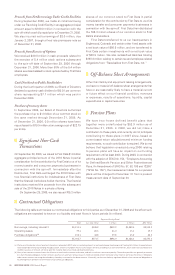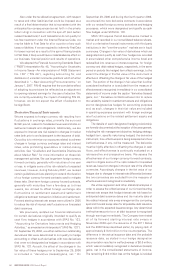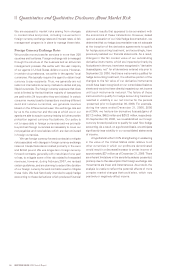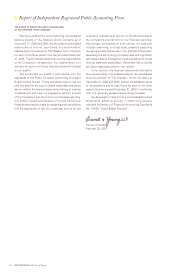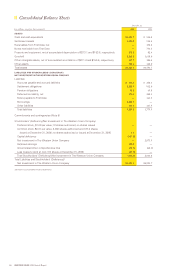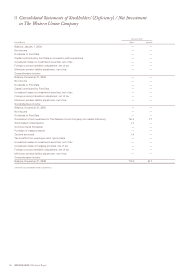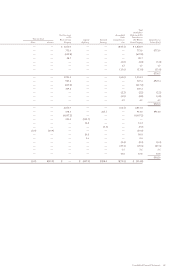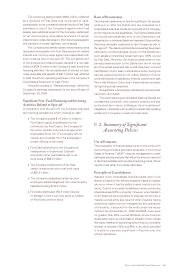Western Union 2006 Annual Report Download - page 61
Download and view the complete annual report
Please find page 61 of the 2006 Western Union annual report below. You can navigate through the pages in the report by either clicking on the pages listed below, or by using the keyword search tool below to find specific information within the annual report. Management’s Discussion and Analysis of Financial Condition and Results of Operations 59
in accumulated other comprehensive loss and will
be reclassified to interest expense over the life of the
related notes.
When the underlying transaction related to a hedge
is no longer considered probable of occurring, the unrealized
gain or loss associated with that hedge is reclassified
from accumulated other comprehensive income or loss
into income. We have not historically reclassified amounts
of unrealized gains or losses on hedges from accumulated
other comprehensive income or loss into income as
a result of the underlying transaction no longer being
considered probable of occurring within that specified
time period.
Capitalized Costs
We capitalize initial payments for new contracts and contract
renewals associated with agent contracts and software
costs. Capitalization of these costs is subject to strict
accounting policy criteria and requires management judgment
as to the appropriate time to initiate capitalization.
Our accounting policy is to limit the amount of
capitalized costs for a given contract to the lesser of the
estimated ongoing future cash flows from the contract or
the termination fees we would receive in the event of early
termination of the contract.
We develop software used in providing services.
Software development costs are capitalized once
technological feasibility of the software has been
established. Costs incurred prior to establishing
technological feasibility are expensed as incurred.
Technological feasibility is established when we have
completed all planning, designing, coding and testing
activities that are necessary to determine that a product
can be produced to meet its design specifications, including
functions, features and technical performance requirements.
Capitalization of costs ceases when the product is available
for general use. Currently unforeseen circumstances in
software development could require us to implement
alternative plans with respect to a particular effort, which
could result in the impairment of previously capitalized
software development costs.
|| New Accounting Pronouncements
Effective January 1, 2007, we adopted FIN 48, which
clarifies the accounting for uncertainty in income taxes
recognized in an enterprise’s financial statements in
accordance with FASB Statement No. 109, “Accounting
for Income Taxes,” and prescribes a recognition threshold
and measurement attribute for the financial statement
recognition and measurement of a tax position taken or
expected to be taken in a tax return. FIN 48 also provides
guidance on derecognition, classification, interest
and penalties, accounting for interim periods, disclosure
and transition.
FIN 48 requires that the cumulative effect of adopting
its provisions be reflected as an adjustment to opening
retained earnings for the year of adoption. We are currently
evaluating the impact of adopting FIN 48, however, we do
not expect the effect of adoption to be significant.
In September 2006, the FASB issued SFAS No. 157,
“Fair Value Measurements” (“SFAS No. 157”), which
defines fair value, establishes a framework for measuring
fair value under accounting principles generally accepted
in the United States of America (“GAAP”), and expands
disclosures about fair value measurements. SFAS No. 157
applies to other accounting pronouncements that require
or permit fair value measurements. The new guidance is
effective for financial statements issued for fiscal years
beginning after November 15, 2007, and for interim periods
within those fiscal years. We are currently evaluating the
potential impact of the adoption of SFAS No. 157; however,
we do not expect the impact to be significant to our
consolidated financial position, results of operations
and cash flows.
On September 29, 2006, the FASB issued SFAS
No. 158, “Employers Accounting for Defined Benefit
Pension and Other Postretirement Plans, An Amendment
of SFAS No. 87, 88, 106 and 132(R)” (“SFAS No. 158”).
The statement requires employers to recognize the
overfunded and underfunded portion of a defined
benefit plan as an asset or liability, respectively, and any
unrecognized gains and losses or prior service costs as a
component of accumulated other comprehensive income.
SFAS No. 158 also requires a plan’s funded status to
be measured at the employer’s fiscal year-end. The
requirement to recognize the funded status of a defined
benefit plan and the disclosure requirements of SFAS
No. 158 are effective for us as of December 31, 2006.
The requirement to measure plan assets and benefit
obligations as of the date of the employer’s fiscal year-
end is effective for us in 2008. The adoption of the
requirements of SFAS No. 158 that became effective on
December 31, 2006 did not have a material impact to the
financial position, results of operations, and cash flows
of our company due to the frozen status of our defined
benefit pension plans; however, we will change our
measurement date from September 30 to December 31
no later than 2008.
In February 2007, the FASB issued SFAS No. 159,
“The Fair Value Option for Financial Assets and Liabilities”
(“SFAS No. 159”). SFAS No. 159 provides companies with
an option to report selected financial assets and liabilities
at fair value, and establishes presentation and disclosure
requirements designed to facilitate comparisons between
companies that choose different measurement
attributes for similar types of assets and liabilities.
The new guidance is effective for fiscal years beginning
after November 15, 2007. We are currently evaluating
the potential impact of the adoption of SFAS No. 159
on our financial position and results of operations.




